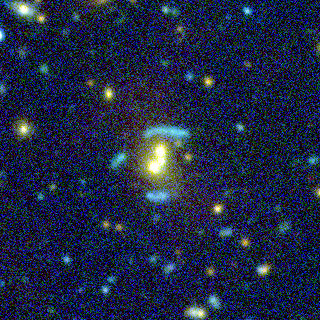
So I’d just finished writing my previous post, and lo and behold, a press release from Hawaii arrives in my email inbox. The image above shows gravitational lensing in a group of galaxies—which is to say, not a cluster of galaxies but a structure much smaller and less massive. This is the first time lensing has been observed resulting from such low-mass collections of galaxies.
Coincidentally, the discovery of the first gravitational lens was published exactly twenty years previous—in January 1987—also by the Canada-France-Hawaii Telescope (CFHT). The original image can be found on the page of images that accompanies the new announcement.
The image lacks much meaning for the uninitiated, although an accompanying image that shows how lensing works can clarify the concept greatly. (Unfortunately, those vary widely in quality and ability to induce or reduce confusion, but that’s a subject for a lengthier post.) Even better, you can connect research images with, say, an animation (with appropriate descriptive elements) that shows lensing, along the lines of one available on the Wikipedia site.
As an aside, I should mention that the light gets bent more by dark matter than the luminous matter in the galaxies. So in a sense, gravitational lenses allow us to visualize dark matter… (That’s my excuse for the subject of this post.)
